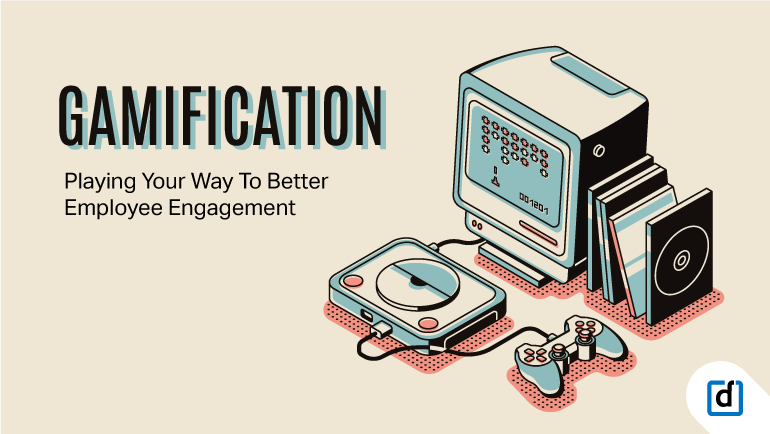

Remember that time when you won the trophy at your school’s sports event? Or received a certificate for showing exemplary performance? Do you remember how energised you felt? Naturally, injecting some element of a game-y competitiveness into any kind of a task is automatically going to be stimulating. And this can be easily applied to your employees at the organisation to bolster employee engagement.
Because engaged employees lead to more productive employees who will help you attain better results in business. Sounds easy, doesn't it?
Well, it isn’t that easy, unless you have tech help.
In order to implement gamification in the organisation successfully, you need to listen to your employees very carefully. Listen to what they have to say about the work that they are expected to do. Do they find it rewarding in itself? Or are they motivated by prizes and rewards? What drives them as an individual? Do they want public recognition? Or do they prefer quiet praise and a salary raise?
It is only then that you will be able to create the right incentives and reward programs that are likely to encourage them to increase their job performance and productivity.
The reason why gamification of processes in most organisations fail is because the managers don’t bother listening to their employees’ unique needs and motivations and end up executing gamification programs that aren’t in line with their employees’ values and needs.
Designing a Gamification Project for your Organisation
Remember your first salary check? It was pretty exciting and you felt delighted.
Today, you might be making more money, but you don't get as excited about it. That's because it's the same stimulus repeating over and over again. Every kind of incentive will need to increase in intensity over time due to habituation, according to Gabe Zicchermann, a gamification expert and public speaker. He presents an interesting narrative on the biochemistry of gamification.
“Whenever you challenge yourself to do a task, no matter how big or small - and you succeed - your brain secretes a magical little bit of dopamine - which makes you feel really good. The more you do this 'challenge - achieve - pleasure' loop, the more dopamine is secreted in your brain making you want to do it even more. Thus the more you succeed, the more you want to succeed.”
This conclusion about the snowballing of success is the key to developing and adopting efficient gamification designs.
Often, traditional reward programs suffer from habituation. Once the brain gets accustomed to a certain reward, the reward no longer has the same impact, and the amount of motivation it gives the person is lessened. Games can easily create a system of increasing levels of hierarchy as users progress through the levels. This way the brain keeps getting reactivated at each new level of reward. Gamification uses this consistent positive feedback to increase motivation by breaking down complex tasks into simple ones that the brain can learn slowly over time, without as much stress.
Gamification, at its core, should have certain qualities to make it more engaging, such as -
- Collaboration
- Community
- Competition
- Points
- Leveling up
- Goals
- Badges
- Fast feedback
- Transparency
- Onboarding
For a gamification program to be successful, the goals need to be well established. The different ways in which employees can participate need to be well defined, and it should be designed to deliver a favorable user experience. It should also be fun, and not a cumbersome or laborious task.
Some examples of how gamification can be incorporated into the workplace are -
- A point-based reward system for employees who hit their KPIs - Some industries offer little incentive to meet targets, especially when it is an industry with a high staff turnover. This often leads to low levels of morale amongst the employees. In such cases, an incentive can make all the difference between KPIs being met or not.
- Introduce badges on your internal platforms - These can be for anything you’d like to see improved, from being punctual on a regular basis to completing monthly expense reports on time.
- Gamify the recruitment and onboarding process - Games can help the people interested in following a career path in that organisation to role play to determine if it’s something that they’d be good at and pursue further. It can also help impart information on a wide range of onboarding topics like security, fraud, ethics, policies and procedures and aid with the retention of the knowledge gained.
- Set up real life scenes for training - Instead of making people go through the job requirements on paper, have a dedicated space where you can run mock scenarios that replicate the situations that they might face on the job, and then test them in a fun way on the protocol that they need to follow.
- Foster leadership - Games can let your organisation leaders or aspiring leaders show just how good they actually are at leading and inspiring people.
Setting up Employee Recognition program is a great way to build a winning culture in an organisation - so if you don’t have one, here's what you need to get started - Download the Rewards and Recognition Starter Kit here.
- Get competitive with workloads - When teams perform similar roles in different geographies, you may notice their performance results varying vastly. By introducing competition you can let them track progress not only against one another but also against other teams at the organisation.
- Weekly Quizzes - Turn meetings into quizzes and engage everyone in the game to find out who is the most up to date on work matters. Set prizes or cash incentives for the top performers. This will motivate employees to look forward to the next weekly meeting, which will ultimately foster healthy competition and keep everyone well prepared.
- Social Recognition - Acknowledging successful employees online not only makes them feel special but also makes their connections, or other job seekers, aware of how well their organisation treats high performers. A higher rating by current employees makes hiring easier, so leverage your social media presence to help both attract and retain top talent.
Successfully executed gamification programs in the workplace preempt a clear understanding of what was expected out of it in the first place. Listening to your employees’ unique needs and motivations so that you can come up with the right kinds of reward programs to implement into your gamification process is crucial. And so is testing the program after its implementation to gauge what worked and what didn’t.
The most simple example of implementation of gamification is that of customers earning (digital) loyalty points and unlocking a reward once they’ve reached a certain level. Similarly, enterprises like Fave and Aarti Industries which use Darwinbox Rewards & Recognition program’s ‘spot rewards’ and ‘badges’ for this purpose have reported great results in both ROI and employee engagement. Darwinbox reward program also uses ‘continuous feedback’ game mechanics like ‘high-fives’ and ‘+1s’ to get feedback from other employees. Gamified recognitions (recognising an employee’s efforts and awarding them with points), feedback and polls are also used, which are proven to increase employee adoption and engagement. Game mechanics, such as badges and leaderboards on the platform are also efficient methods to create continuous development amongst employees. Even for leaderboards that are reset, the recognitions and badges will demonstrate what the employees have achieved in the past.
Keeping these basic tips in mind while laying out the gamification blueprint for your workplace will help you in achieving the desired organisational goals much faster.



Speak Your Mind